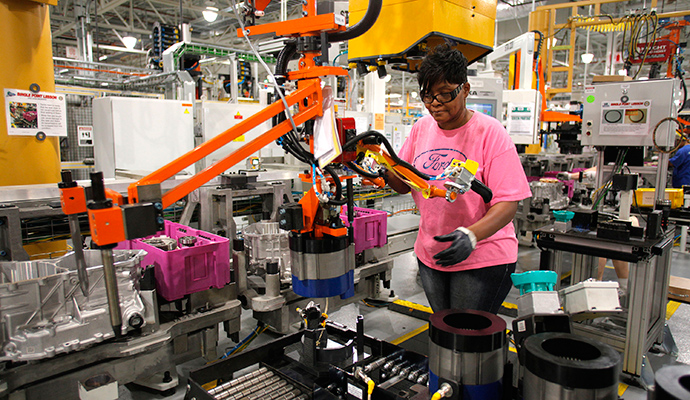How to be a socially responsible investor
Everyone can win


You probably consider yourself to be a pretty values-driven person.
Maybe you're rigid about recycling, always support your local firefighters, volunteer at the soup kitchen during the holidays, and try to donate a pint of blood to the Red Cross.
What you get in return is the feeling that you've done your part to make the world a little bit of a better place.
The Week
Escape your echo chamber. Get the facts behind the news, plus analysis from multiple perspectives.

Sign up for The Week's Free Newsletters
From our morning news briefing to a weekly Good News Newsletter, get the best of The Week delivered directly to your inbox.
From our morning news briefing to a weekly Good News Newsletter, get the best of The Week delivered directly to your inbox.
But what if you could give — and get back? Watch your money make a difference and give yourself an opportunity to build a nest egg?
Enter socially responsible investing, or SRI.
At its core, it's when you weigh both social impact and financial return while choosing investments for your portfolio — and it's become an increasingly popular way for people to invest in causes they believe in.
In 2013, $6.57 trillion in assets under management were devoted to socially responsible investing — an increase of 76 percent since 2012, according to the Forum for Sustainable and Responsible Investment in the U.S., or US SIF.
A free daily email with the biggest news stories of the day – and the best features from TheWeek.com
Nancy Somers, a Minneapolis–based life coach, began shifting parts of her portfolio about a decade ago into more SRI-oriented investments because "it's important to me [to know] where my money is going and what it's doing in the world," she says. Somers invests in a mutual fund that tracks socially responsible companies, as well as bonds and other micro-lending vehicles that enable her to provide financing for people living in poverty.
"I researched a lot and found the funds that I felt were doing what I wanted [them] to do," she says, noting that she's owned her mutual fund for five years and has been very pleased with its performance. And her microfinance efforts "have enabled me to do one-on-one lending — I've gotten a lot of satisfaction out of it [and have been able to] support many people."
Interested in putting your own money where your values are? We delve into four of the most common ways to get started with SRI, so that doing good goes from just being a warm and fuzzy feeling to something you can take to the bank.
How socially responsible equity funds work
You probably already have some exposure in your portfolio to exchange-traded funds and mutual funds that track the performance of a specific equity index, like the S&P 500, or perhaps you follow the stocks of companies based on size, also known as market capitalization.
So why not invest in funds comprised of companies that follow socially responsible principles?
These types of equity funds hold companies that have met certain benchmarks for environmental, social, and corporate governance standards, also known as ESG. These benchmarks can range from how well they adhere to sustainability practices to their business ethics, such as having strong measures in place to prevent fraud or employment violations.
According to US SIF, $1 out of every $6 in assets under professional management is screened for ESG-related factors.
SRI funds also tend to exclude companies — such as manufacturers of firearms, tobacco producers, or alcohol companies — that produce controversial products or services.
Katherine Collins, founder of SRI research firm Honeybee Capital and author of The Nature of Investing, likes these types of mutual funds and ETFs as a way for the typical investor to dip their toes in SRI.
"[These are good for] any investor looking to align their investing with the rest of their lives," Collins says. "They are time-tested traditional vehicles, meant for average folks in it for the long haul." Another pro that Collins points out: "These investments usually have fairly low fees and low minimums."
And, as with non-SRI funds, they can "make it relatively easy to get diversification in one fund pick," says Brian Mahany, CFP® and founder of Sustainable Financial Planning in Toledo, Ohio. "The caveat is that once you get into a niche, like wind power, there isn't a lot of diversity to offer. So look at your goals," he adds, to really see if those types of niche investments would be a good fit.
For the most part, larger SRI indexes carry a good mix of companies and aren't as restrictive as some investors have perceived them to be. The same big tech or consumer products company you may get access to through a typical index fund, for example, could very well be included in an SRI fund.
How socially responsible bond funds work

In the same way that equities-based funds have an SRI equivalent, so do those that track fixed income, also know as bonds. SRI bond funds can help diversify your portfolio, as well as provide an opportunity to partake in values-based investing.
"Almost anybody who is using mutual funds for an SRI mix would be a good candidate" for SRI bond funds, says Tom Nowak, author of the forthcoming book Low-Fee Vegan Investing and a CFP® and founder of Quantum Financial Planning in Grayslake, Illinois. "Very few folks will be 100 percent in stocks, so [it's one way to] balance a portfolio."
SRI bond funds operate on similar principles as their equity-based counterparts, and are composed only of bonds issued by companies, governments, banks, or nongovernmental organizations to help fund socially responsible projects.
An automaker, for instance, might issue a corporate bond to help finance the development of more energy-efficient cars. In fact, so-called "green" or "climate" bonds are among the most popular SRI-based bonds out there — the S&P estimates that the green corporate bond market will double in size this year.
"If you're interested in corporate bonds, there's no reason not to be interested in SRI bonds," Collins says. "You want to think about the long term here."
Just make sure to keep a close eye on fees, cautions Nowak, who notes that the screening that's required for SRI bonds can result in added administrative costs that can eat into returns, which tend to be lower for bonds than for equities.
How microfinancing works
Ever wondered how you could get involved in causes halfway across the world, without having to hop on a flight? The answer could very well lie in microfinance.
"It describes [extending] financial services to low-income individuals or those who do not have access to typical banking services," explains Jason Riggs, director of communications and media alliances for nonprofit crowdfunding microfinance site Kiva.org.
One of the most common forms that microfinance takes is when individuals loan small amounts to others — typically small business owners in developing areas — in an effort to help people work their way out of poverty and contribute to local economic development.
Riggs gives an example: One Kiva loan recipient, a woman in India who was the only tailor in her village, was able to double her business after getting a microloan that enabled her to purchase a second sewing machine.
"Oftentimes, people around the world have the passion, but they don't have the money [to grow their businesses]," Riggs says. "The most popular sectors for loans are the food industry, agriculture and buying things in bulk for retail."
Perhaps the biggest benefit to microfinance is the generally low cost of entry. Kiva, for example, only requires $25 to start lending. Another peer-to-peer microfinance site, Zidisha.org, only requires $1 to start.
"I think it's one way for people to get involved in SRI," Collins says. "Microfinance is a perfect example of a sector where you have billionaires investing, as well as folks who got $25 for Christmas from their grandparents."
For the investor, returns can vary greatly, and as a lender, you still assume risk that you may not get all of your principal back. Additionally, some organizations, like Kiva, don't pay out any interest, so if you keep your repaid funds in a Kiva account — versus cashing out or making another loan — you're essentially using it as a no-interest savings account.
Other microfinance institutions, by contrast, may lend at high interest rates. The global average is around 35 percent, but it can be much higher, depending on where in the world your loan recipient is based or if you're using a for-profit lender. While this could mean a stronger return for an investor, some people may feel uncomfortable lending at such a high rate.
Bottom line: It's important to know all of the details surrounding your microloan and really assess what you're hoping to get from being a lender.
"If you want to think about [microfinance] as gifting, there are a lot of choices — and if you want to make money, there are many choices too," Collins says. "It's untrue that you won't gain [a return] through microfinance — it has an unusually wide range of ways to get involved."
Somers has made loans ranging from $25 to $500 through microfinancing, and likes its global reach. "I like to say I'm an 'international financier' tongue-in-cheek," she says. "There are people out there who need my money more than I do."
How shareholder activism works

When you think about shareholder activists, you probably envision hedge-fund kings like Carl Icahn or Bill Ackman, who can use their standing as big-time shareholders to try and force change on the corporations they invest in.
But you don't have to be a billionaire to try and sway a company toward making more socially responsible decisions.
"Even if you own just 100 shares, you have a right to be heard," Collins says. "And you can do it via shareholder resolutions. In fact, some of the best shareholder activists are nuns."
Shareholder resolutions are proposals that investors (who meet certain qualifications) bring up for a vote, so that their fellow investors can weigh in on them at shareholder meetings. Activist investors have used these resolutions to push for votes on everything from investigating how a company contributes to greenhouse-gas emissions to being more vigilant when it comes to not using sweatshops.
Sometimes the proposals pass and sometimes they don't, but they give investors an opportunity to make their opinions known nonetheless.
If owning direct shares in a company doesn't appeal to you, you can take a look at activist funds that are set up similarly to mutual funds — they track the stocks of companies that have been targeted specifically by shareholder activists. "They enable the average investor to enter into [shareholder activism]," Mahany says.
But shareholder activism isn't something to be taken lightly. No matter how much stock you buy, there's no guarantee your activism will achieve results — and you could be putting your portfolio at risk by being too concentrated in a stock position.
"I always come back to goals, risk and asset allocation," Mahany says. "[If you want to try shareholder activism], you might want to do it with just 5 percent to 10 percent of your allocation. But you may want to focus on your other goals first, and then, perhaps, it's something to look at."
This story was originally published on LearnVest. LearnVest is a program for your money. Read their stories and use their tools at LearnVest.com.
More from LearnVest...
-
 Received a gift card this holiday season? Here’s how to maximize it.
Received a gift card this holiday season? Here’s how to maximize it.The Explainer Make the most of your present
-
 ‘Lumpy skin’ protests intensify across France as farmers fight cull
‘Lumpy skin’ protests intensify across France as farmers fight cullIN THE SPOTLIGHT A bovine outbreak coupled with ongoing governmental frustrations is causing major problems for French civil society
-
 The best books of 2025
The best books of 2025The Week Recommends A deep dive into the site of a mass shooting, a new release from the author of ‘Atonement’ and more